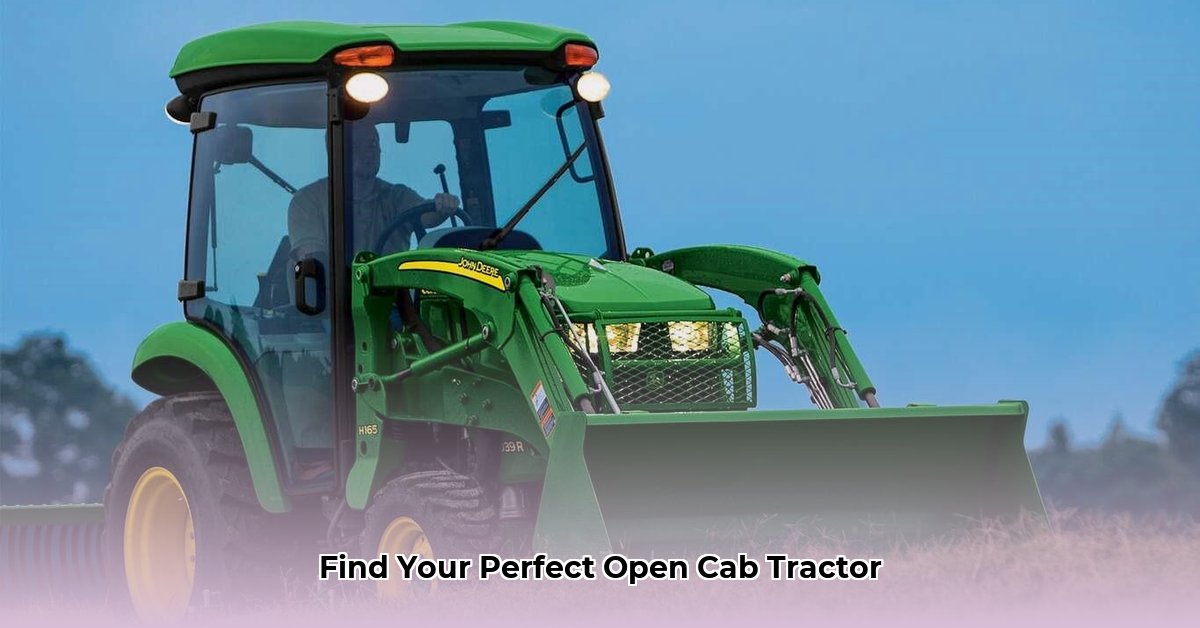
Finding the perfect open cab tractor requires careful consideration of your needs and budget. This guide provides a step-by-step process to help you choose the right machine for your farm. Whether you're a seasoned farmer or a newcomer, this comprehensive guide will empower you to make an informed decision. For more info on tractors with cabs, see this helpful guide on smallest tractors with cabs.
Understanding Your Farming Needs
Before exploring tractor models, define your farming operation. What tasks will the tractor perform? Are you working a small hobby farm or a large-scale operation? Consider the size of your fields, terrain type (flat, hilly, etc.), and the types of implements you'll use. Will your farming needs change in the future? Planning for future expansion will influence your tractor selection. For instance, a small hobby farmer might need a compact utility tractor (CUT) for mowing and light tillage, while a large-scale operation will require a much larger, more powerful model. Isn't it essential to match tractor capability to your workload?
Open Cab vs. Enclosed Cab: A Comparative Analysis
The open cab versus enclosed cab decision hinges on comfort versus cost. Open cabs offer lower upfront costs and excellent visibility, but expose the operator to the elements. Enclosed cabs provide climate control and enhanced safety, but at a higher initial price.
| Feature | Open Cab | Enclosed Cab |
|---|---|---|
| Cost | Lower initial investment | Higher initial investment |
| Visibility | Excellent, panoramic view | Good, but potentially obstructed by windows |
| Climate Control | None; exposed to weather | Excellent; heating and air conditioning provided |
| Safety | Higher risk of injury from weather and impacts | Enhanced safety and protection from the elements |
| Maintenance | Typically simpler and less expensive | More complex systems; potentially higher maintenance costs |
| Maneuverability | Often better in tight spaces | Slightly less maneuverable in very confined areas |
Choosing the Right Tractor Size: Power and Performance
Selecting the appropriate tractor size is critical for efficiency and safety. CUTs are suitable for smaller properties and lighter tasks, while larger tractors are necessary for extensive acreage and heavier workloads. Horsepower ratings directly correlate to the tractor's power capabilities. A tractor that is too small will struggle with heavy tasks and increase the risk of accidents; conversely, an oversized tractor will be inefficient for smaller jobs and expensive to maintain. How much power do you realistically need for your anticipated tasks?
Exploring Aftermarket Options: Cab Additions
Adding a cab as an aftermarket modification offers flexibility. This allows farmers to upgrade later if their budget permits or their needs change. However, aftermarket cabs can be expensive to install, might not fit perfectly, and could potentially decrease fuel efficiency. Is a future cab upgrade a viable financial and logistical option for your farm?
Essential Considerations Beyond the Cab
Several key factors influence your tractor choice, regardless of cab type.
Safety Features: Invest in tractors with Roll Over Protective Structures (ROPS) to protect the operator in case of a rollover. ROPS are essential safety components that reduce the risk of serious injury. Are you prioritizing safety features in your tractor selection process?
Maintenance Costs: Factor in the ongoing expense of regular maintenance, repairs, and parts replacement. Preventative maintenance is crucial for longevity and reliable operation. Consider the long-term maintenance costs along with the initial purchase price.
Warranty: A comprehensive warranty protects you against unexpected repairs. Carefully compare warranty coverage across different manufacturers and models. Does the warranty cover essential components and potential failures?
Dealer Support: A reliable dealer with good parts and service is crucial. Access to prompt service and support can minimize downtime. Can your chosen dealer provide reliable and timely service?
Choosing a Cab for Your Climate and Budget: A Practical Guide
Demand for tractor cabs is high due to improved operator comfort and safety. Factory-installed cabs offer premium features, whereas field-installed ones offer cost savings and customization flexibility for existing tractors. Cab selection hinges heavily on the climate and the operator's budget. The suitability of a cab depends on the specific application, and prices vary substantially.
Step-by-Step Guide:
Assess your climate: Consider extreme temperatures, rainfall, and dust conditions. This will determine the required HVAC system, sealing, and wiper efficiency.
Determine your budget: Factory-installed cabs are usually more expensive than field-installed options. Set a realistic budget before you start shopping.
Evaluate key cab features: Prioritize features like HVAC system capability, visibility (window size and placement), soundproofing, durability of materials, and ergonomic design.
Compare factory-installed vs. field-installed: Factory-installed offers seamless integration and premium features, but the field-installed option provides flexibility and potential cost savings.
Research Models and Manufacturers: Research various models, compare specifications, and seek feedback from other farmers.
Compare Prices and Features: Create a spreadsheet to compare prices, features, and warranties.
Consider Long-Term Implications: Factor in maintenance costs and potential repairs. A reputable dealer with quality service and support is vital.
Choosing the right open cab tractor is a significant investment. Thorough research and careful consideration of the factors outlined above will ensure you select a dependable and efficient machine for years to come.